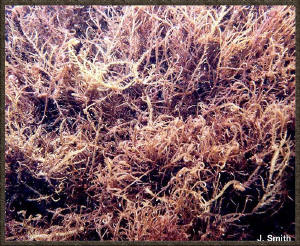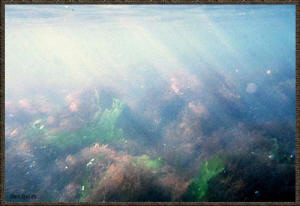|
Invasive Algae Home Red Algae Green Algae Brown Algae Seagrasses Glossary |
|
|||||||||
|
|
|||||||||
|
|||||||||
|
Click on pictures for larger images
Hypnea musciformis is a highly opportunistic invader well known for its large floating blooms in coastal Maui. Large biomass washes up on the beaches of O‘ahu and Maui. This alga is easily identified by the flattened, broad hooks at the end of many branches.
Distribution of
Hypnea musciformis in Hawaiian Islands.
Hypnea musciformis beds with Ulva fasciata at Maalea, Maui. |
|
||||||||
|
Description Clumps or masses of loosely intertwined, cylindrical branches, 10 - 20 cm tall, 0.5 - 1.0 cm diameter, that become progressively more slender towards tips. Firm, cartilaginous, highly branched. Branching is variable and irregular, often tendril-like and twisted around axes of other algae. The ends of many axes and branches are flattened with broad hooks. Holdfasts are small, inconspicuous, or lacking. Usually red, but can be yellowish brown in high light environments or nutrient poor waters.
Easily distinguished from other native Hypnea spp. by the presence of flattened, broad hooks at the tips of the branches (see arrow on above figure). Often found as an epiphyte on reef algae such as Sargassum echinocarpum, Sargassum polyphyllum, and Acanthophora spicifera.
Structural Features Medulla appear parenchymatous around central axial cell; cortical filaments with few divisions on radii, outer layer pigmented. Tetrasporangia zonately divided, in raised nemathecia, usually on ultimate branches; spermatangia borne in chains in slightly swollen nemathecia at base of branchlets. Cystocarps conspicuous, rounded, without discharge pore.
Habitat Hypnea musciformis is common on calm intertidal and shallow subtidal reef flats, tidepools and on rocky intertidal benches. Most often found low intertidal to shallow subtidal reef flats, attached to sandy flat rocks, or frequently epiphytic on Sargassum and other algae. In bloom stage, may be found free-floating.
Distribution Hawai‘i: O‘ahu, Moloka‘i, and Maui.Mechanism of Introduction: Introduced to Kane‘ohe Bay in 1974 for commercial cultivation. Worldwide: Mediterranean, Philippines, Indian Ocean, Caribbean to Uruguay.
Ecology/Impact Hypnea musciformis is an extremely abundant alga that is commercially cultivated throughout its world distribution as a food source and for its kappa carrageenan. This alga was purposefully introduced to Kane‘ohe Bay in 1974 from Florida for mariculture. This introduced invasive spread quickly, reaching other islands by 1982. The success of this alga in Hawai‘i is likely due to a rapid growth rate, ability to epiphytize other algae and easy fragmentation. Drifting fragments reattach to other algae, especially Sargassum, which can become detached during storms and float long distances, carrying the epiphytic H. musciformis with it. Dispersal may well have been enhanced via interisland travel with fouled boat hulls.
H. musciformis is often found in large, nearly unialgal mats, and during the winter can represent 2/3 of the biomass of drift algae on windward and leeward beaches on Maui. These mats are tossed ashore in windrows up to 1.5 feet and are considered an odiferous pest. In peak blooms, thousands of pounds wash up on Maui beaches.
Soon after its introduction, it was identified as a food source for the green sea turtle, Chelonia mydas. H. musciformis can make up a significant part the their diet, sometimes representing 99-100 percent of the seaweed mass found in their stomachs, but the actual nutritional value has not been determined.
|
|||||||||
|
|
|
|
References Abbott, I.A., 1999. Marine Red Algae of the Hawaiian Islands. Bishop Museum Press, Honolulu, Hawai‘i. Littler, D.S. and Mark M., 2000. Caribbean Reef Plants. OffShore Graphics, Washington, D.C. Russell, D.J., 1992. The ecological invasion of Hawaiian reefs by two marine red algae, Acanthophora spicifera (Vahl) Bøerg. and Hypnea musciformis (Wulfen) J.Ag., and their association with two native species, Laurencia nidifica J.Ag. and Hypnea cervicornis J.Ag. ICES Mar. Sci. Symp., 194: 110-125. Russell, D. J. and G. H. Balazs, 1994. Colonization by the alien marine alga Hypnea musciformis (Wulfen) J. Ag. (Rhodophyta: Gigartinales) in the Hawaiian Islands and its utilization by the green turtle, Chelonia mydas. Aquatic Biology. 47:53-60. Russell, D. J. and G. H. Balazs. 2000. Identification manual for dietary vegetation of the Hawaiian green turtle, Chelonia mydas. NOAA TM-NMFS-SWFSC-294. 49 pp. Schneider, D.W, and R.B. Searles, 1991. Seaweeds of the Southeastern United States. Duke University Press, London, England.
|
Web Pages
Ecological Success of Alien/Invasive Algae in Hawai‘i:
http://www.botany.hawaii.edu/GradStud/smith/websites/
Marine Invasives in Hawai‘i:
|

